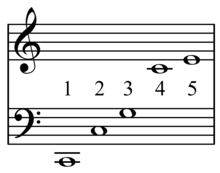

The harmonic scale is a "super-just" musical scale allowing extended just intonation, beyond 5-limit to the 19th harmonic (Play), and free modulation through the use of synthesizers. Transpositions and tuning tables are controlled by the left hand on the appropriate note on a one-octave keyboard.
For example, if the harmonic scale is tuned to a fundamental of C, then harmonics 16–32 are as follows:
| Notation | Harmonics | Cents | ||
|---|---|---|---|---|
| C | C | C | 16 | 0 |
| C♯ | C |
D♭ | 17 | 104.96 |
| D | D | D♮ | 18 | 203.91 |
| E♭ | E |
E♭ | 19 | 297.51 |
| E♮ | E♮ | E↓ | 20 | 386.31 |
| F | F |
F |
21 | 470.78 |
| F♯ | F↑ | F |
22 | 551.32 |
| G | G | G | 24 | 701.96 |
| A♭ | A |
A |
26 | 840.53 |
| A♮ | A♮+ | A♮ | 27 | 905.87 |
| B♭ | B |
B |
28 | 968.83 |
| B♮ | B♮ | B♮↓ | 30 | 1088.27 |
| C' | C' | C' | 32 | 1200 |
Some harmonics are not included: 23, 25, 29, & 31. The 21st is a natural seventh above G, but not a great interval above C, and the 27th is a just fifth above D. Play diatonic scale

It was invented by Wendy Carlos and used on three pieces on her album Beauty in the Beast (1986): Just Imaginings, That's Just It, and Yusae-Aisae. Versions of the scale have also been used by Ezra Sims, Franz Richter Herf and Gosheven.
Number of notes
Though described by Carlos as containing "144 distinct pitches to the octave", the twelve scales include 78 (= 12(12+1)/2) notes per octave.
Technically there should then be duplicates and thus 57 (= 78 − 21) pitches (21 = 6(6+1)/2). For example, a perfect fifth above G (D) is the major tone above C.
References
- ^ Milano, Dominic (November 1986). "A Many-Colored Jungle of Exotic Tunings", Keyboard.
- Benson, Dave (2007). Music: A Mathematical Offering, p. 212. ISBN 9780521853873.
- Sims, Ezra (1987), "Observations on Microtonality Issue: Letters", Computer Music Journal, 11 (4): 8–9, doi:10.2307/3680228, JSTOR 3680228
- Carlos, Wendy (1987), "Tuning: At the Crossroads", Computer Music Journal, 11 (1): 29–43, doi:10.2307/3680176, JSTOR 3680176
External links
- "Wendy Carlos Harmonic scale", Microtonal-Synthesis.com.
| Musical tunings | |||||||
|---|---|---|---|---|---|---|---|
| Measurement | |||||||
| Just intonation | |||||||
| Temperaments |
| ||||||
| Traditional non-Western | |||||||
| Non-octave |
| ||||||
| Musical scales (list) | |||||||||||||||||||||
|---|---|---|---|---|---|---|---|---|---|---|---|---|---|---|---|---|---|---|---|---|---|
| Main Western | |||||||||||||||||||||
| Other types | |||||||||||||||||||||
| Ethnic origin | |||||||||||||||||||||
| Non-octave | |||||||||||||||||||||
| Modes |
| ||||||||||||||||||||
| Number of tones |
| ||||||||||||||||||||
| Wendy Carlos | |
|---|---|
| Albums |
|
| Soundtrack albums | |
| Musical tunings | |
This music theory article is a stub. You can help Misplaced Pages by expanding it. |